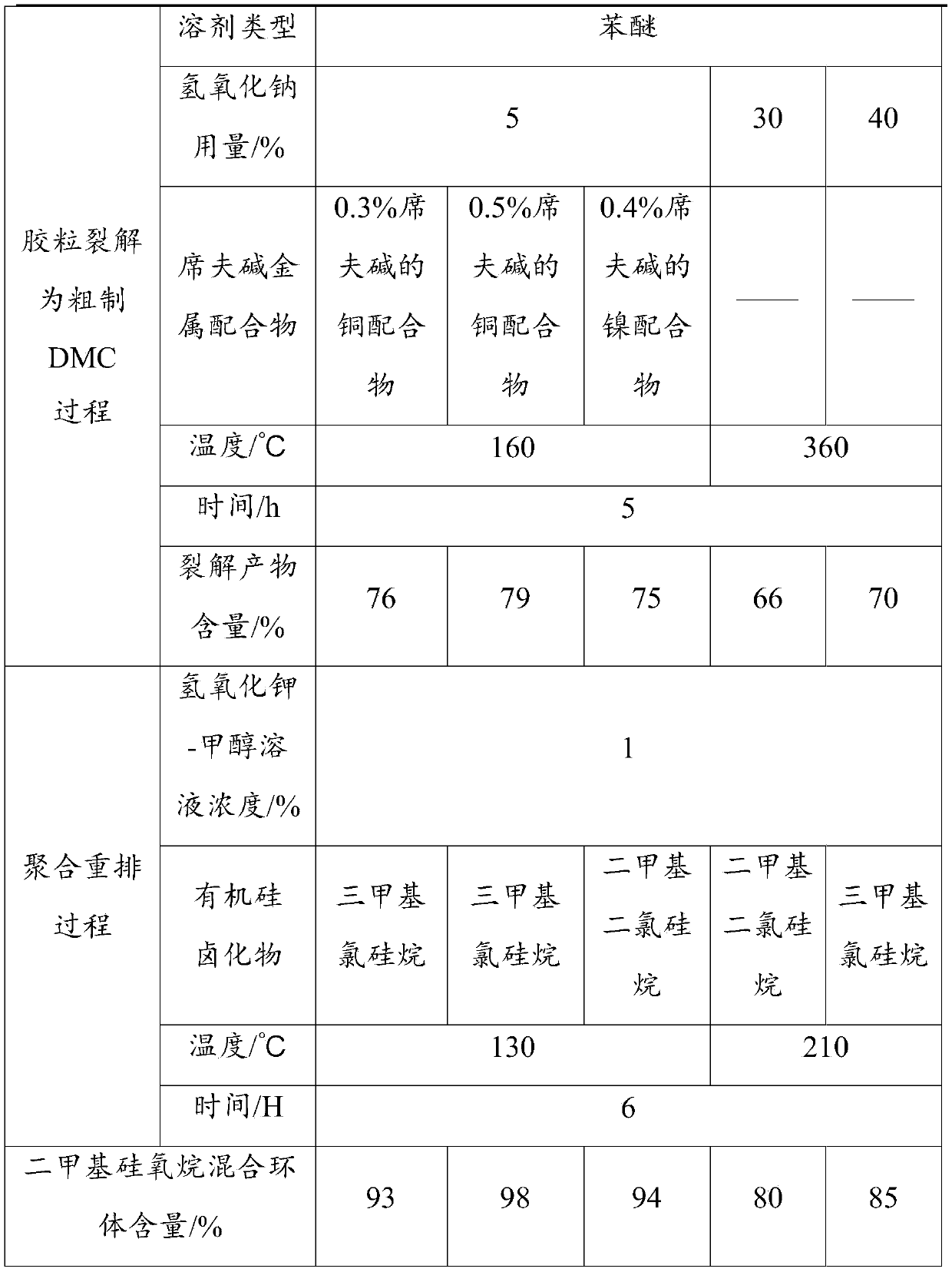High-efficiency cracking recovery method for silicone rubber waste
A silicon rubber waste and recycling method technology, applied in the field of materials, can solve the problems of increased process difficulty, large acid dosage, high process temperature, etc., and achieves the effects of improving cracking efficiency, less basic catalyst, and lowering process temperature.
- Summary
- Abstract
- Description
- Claims
- Application Information
AI Technical Summary
Problems solved by technology
Method used
Image
Examples
Embodiment 1
[0042] (1) Crushing: Wash the waste dimethyl silicone rubber, cut into pieces, and dry it. After cleaning the surface impurities by ultrasonic or mechanical vibration, the waste silicone rubber is crushed into particles by a rubber crusher, with a particle size of 1-2mm;
[0043] (2) Double cracking: Put the crushed silicone rubber particles into the cracking reactor, then add phenyl ether solvent and the copper complex of 5% sodium hydroxide and 0.3% of the weight of sodium hydroxide to the weight of the silicone rubber Depolymerization was carried out at a high temperature of 150°C under a nitrogen atmosphere for 3 hours to obtain crude DMC with a cracked product content of 79%;
[0044] (3) Polymerization rearrangement: Add the crude DMC to the rearrangement reactor, then add a potassium hydroxide-methanol solution with a concentration of 1%, the amount is 15% of the crude DMC mass, and 1% of the crude DMC mass Chlorotrimethylsilane was reacted at 110°C and under vacuum con...
Embodiment 2
[0047] (1) Crushing: Wash the waste dimethyl silicone rubber, cut into pieces, and dry it. After cleaning the surface impurities by ultrasonic or mechanical vibration, the waste silicone rubber is crushed into particles by a rubber crusher, with a particle size of 1-3mm;
[0048] (2) Double cracking: put the crushed silicone rubber particles into the cracking reactor, then add tetraethylene glycol dimethyl ether solvent and sodium hydroxide in an amount of 5% of the weight of the silicone rubber, and 0.5% of the weight of the sodium hydroxide. Copper complexes of Kufine base were depolymerized at a high temperature of 170° C. under a nitrogen atmosphere for 3.5 hours to obtain crude DMC with a cleavage product content of 82%;
[0049] (3) Polymerization rearrangement: Add the crude DMC to the rearrangement reactor, then add a potassium hydroxide-methanol solution with a concentration of 1%, the amount is 15% of the crude DMC mass, and 1.5% of the crude DMC mass Chlorotrimethyl...
Embodiment 3
[0052] (1) Crushing: Wash the waste dimethyl silicone rubber, cut into pieces, and dry it. After cleaning the surface impurities by ultrasonic or mechanical vibration, the waste silicone rubber is crushed into particles by a rubber crusher, with a particle size of 2-3mm;
[0053] (2) Double cracking: Put the crushed silicon rubber particles into the cracking reactor, then add phenyl ether solvent and the nickel compound of 5% sodium hydroxide and 0.4% of the weight of sodium hydroxide for the weight of the silicone rubber Depolymerization was carried out at a high temperature of 190°C under a nitrogen atmosphere for 5 hours to obtain crude DMC with a cracked product content of 79%;
[0054] (3) Polymerization rearrangement: Add the crude DMC to the rearrangement reactor, then add a potassium hydroxide-methanol solution with a concentration of 1%, the amount is 15% of the crude DMC mass, and 1.5% of the crude DMC mass Dimethyldichlorosilane was reacted at 110°C and under vacuum...
PUM
| Property | Measurement | Unit |
|---|---|---|
| particle diameter | aaaaa | aaaaa |
| particle diameter | aaaaa | aaaaa |
| particle diameter | aaaaa | aaaaa |
Abstract
Description
Claims
Application Information
 Login to View More
Login to View More - R&D
- Intellectual Property
- Life Sciences
- Materials
- Tech Scout
- Unparalleled Data Quality
- Higher Quality Content
- 60% Fewer Hallucinations
Browse by: Latest US Patents, China's latest patents, Technical Efficacy Thesaurus, Application Domain, Technology Topic, Popular Technical Reports.
© 2025 PatSnap. All rights reserved.Legal|Privacy policy|Modern Slavery Act Transparency Statement|Sitemap|About US| Contact US: help@patsnap.com


